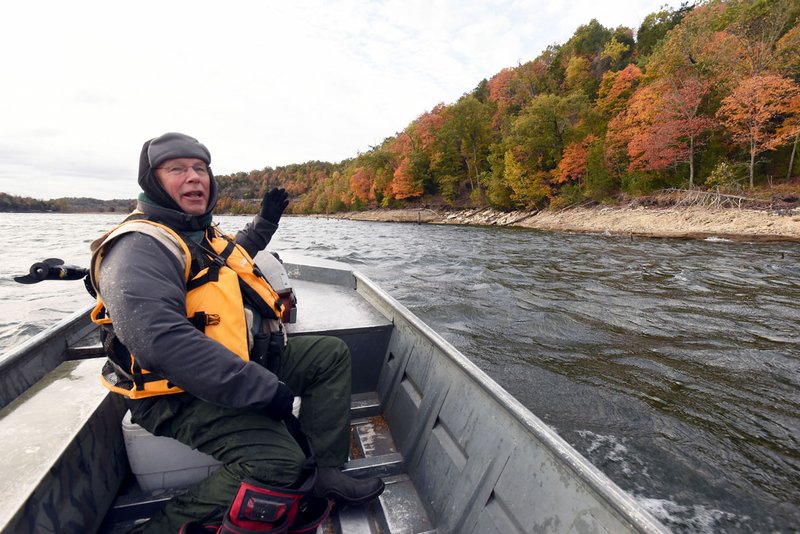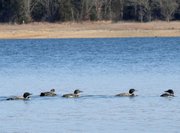Winter guests take their place when summertime lake visitors mothball their boats as temperatures fall.
The number of ducks, geese, bald eagles and loons swell as leaves drop and water turns cold. These feathered migrants bring their seasonal sights and sounds to streams, small lakes and big reservoirs.
Loons a bonus on eagle cruises
Hobbs State Park-Conservation Area adds more eagle-viewing cruises on Beaver Lake for the holidays where loons and other birds might also be seen.
Trips take place this Saturday and Sunday, as well as Dec. 16-17, Dec. 22-23, Dec. 27-31 and Jan 1. Cruises set sail at 3 p.m. aboard the park’s pontoon boat. Trips last about 90 minutes.
Cost is $10 for adults or $5 for children age 6-12. There’s no charge for kids 6 and under. Make reservations by calling the park visitor center, 479-789-5000 or stopping by the center on Arkansas 12 one-quarter mile east of War Eagle Road.
Source: Staff report
The most spine-tingling autumn sound at Beaver Lake may be the long, mournful and mysterious call of loons. At dusk when the water is glass smooth and shrouded in mist, a loon's distinctive, whistling song might be heard.
Listening to loons on the lake is special as hearing elk bugle along the Buffalo National River. Bird enthusiasts like Joe Neal of Fayetteville look for loons when the wind howls from the north in late fall.
And howl it did, with gale force on Beaver Lake, as Neal and a friend bobbed on wind-whipped waves in a small boat on a quest for loons. It was a scouting mission, this foray on rough water in late October.
Neal had two loon-viewing pontoon boat cruises to guide in November for Hobbs State Park-Conservation Area. This pre-trip investigation aimed to find out if loons had arrived from up north.
"With loons it's all about the fish. That's what brings them to Beaver Lake," Neal said, scanning a swath of lake with binoculars. Late October through mid-November is prime time to see loons on the lake. Some are around all winter, Neal added.
The area around Rocky Branch park is the widest part of Beaver Lake and an excellent place to see loons, he coached. Neal is a walking field guide when it comes to birds, loons included. He leads field trips for the Northwest Arkansas Audubon Society, gives talks on birds and has written several books about birds and birding.
Neal bounced on his seat in the little boat. Conditions became more hazardous on this 40-degree morning. North wind blew up high waves frosted with white caps. Anyone would be plum loony to stay out on the water, so the skipper made a bee line for the safety of the boat launching ramp.
View of any loons would be lost in the trough of waves two to three feet high. Neal hoped his passengers would see loons on the Nov. 4 and Nov. 25 cruises.
And see them, they did.
"We saw a bunch of loons on Nov. 4," Neal reported after the trip. "At least five." That cruise was at the peak of loon migration time.
No loons were seen on the Nov. 28 cruise. The trip was first set for Nov. 18, but got postponed because of heavy wind.
"To me this fits the migration pattern. It was already pretty much over by the 28th," Neal said. Bird watchers did see ducks, gulls and bald eagles on the cruise.
While Beaver Lake is home to a passel of loons all winter, nearby Lake Tenkiller in northeast Oklahoma is the Mother Lode of loons during winter. Neal traveled to public access areas on Lake Tenkiller and counted 186 loons on a recent visit.
It baffles Neal why Beaver Lake has fewer loons than Tenkiller. Both lakes are loaded with threadfin shad and other bait fish that loons eat.
There's good reason the bird man will keep looking for loons, waterfowl and song birds at Beaver Lake.
"One of my goals is to learn more about how birds use Beaver Lake as more people move to the area," he said.
"As we move from 500,000 people toward 800,000, we're going to need increased advocacy for the water quality of this lake. We're going to need more people to get involved with groups that protect the lake and its watershed."
No matter where one finds them, the song of a loon is music in the wild.
Flip Putthoff can be reached at [email protected] or on Twitter @NWAFlip
Sports on 12/05/2017


